Human Resource Management Assignment 2: Training Outcomes
VerifiedAdded on 2022/11/14
|11
|2377
|415
Homework Assignment
AI Summary
This assignment, focusing on Human Resource Management, analyzes the training needs of the United States Marine Corps (USMC) to address organizational challenges, particularly in skill enhancement, retention, and technological advancements. The assignment identifies the target group for training and explores the training issues faced by the USMC. It outlines expected training outcomes, including skill enhancement, increased retention and collaboration, and technological skills enhancement. The expected performance benefits are detailed, emphasizing improved soldier skills, job satisfaction, and collaboration. Furthermore, the assignment identifies performance gaps through clarification of learning objectives, determination of skills and knowledge, and evaluation of current resources. Finally, it details how training can close these gaps by addressing the technological needs of the organization. The document references various sources to support the analysis and findings.
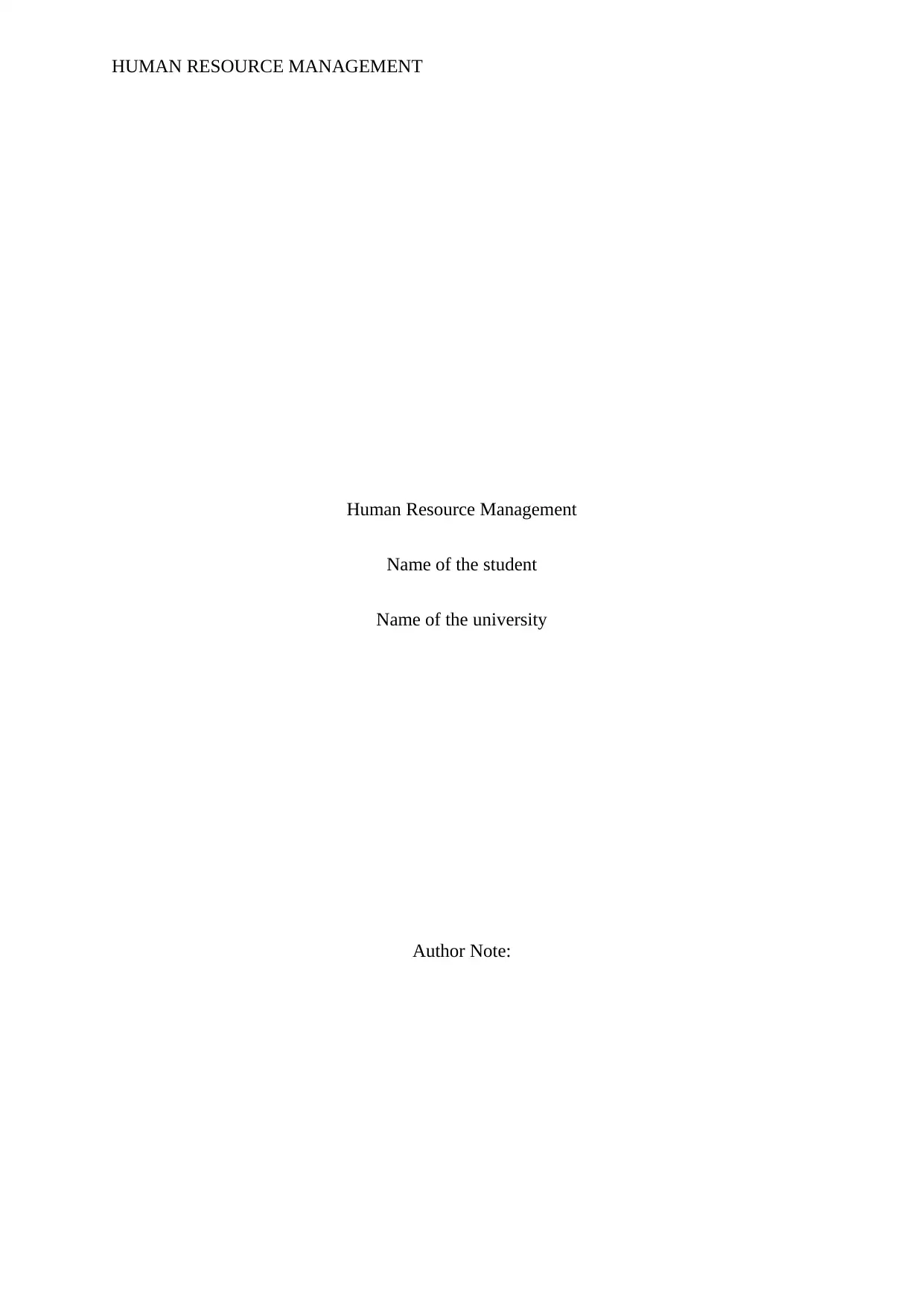
HUMAN RESOURCE MANAGEMENT
Human Resource Management
Name of the student
Name of the university
Author Note:
Human Resource Management
Name of the student
Name of the university
Author Note:
Paraphrase This Document
Need a fresh take? Get an instant paraphrase of this document with our AI Paraphraser
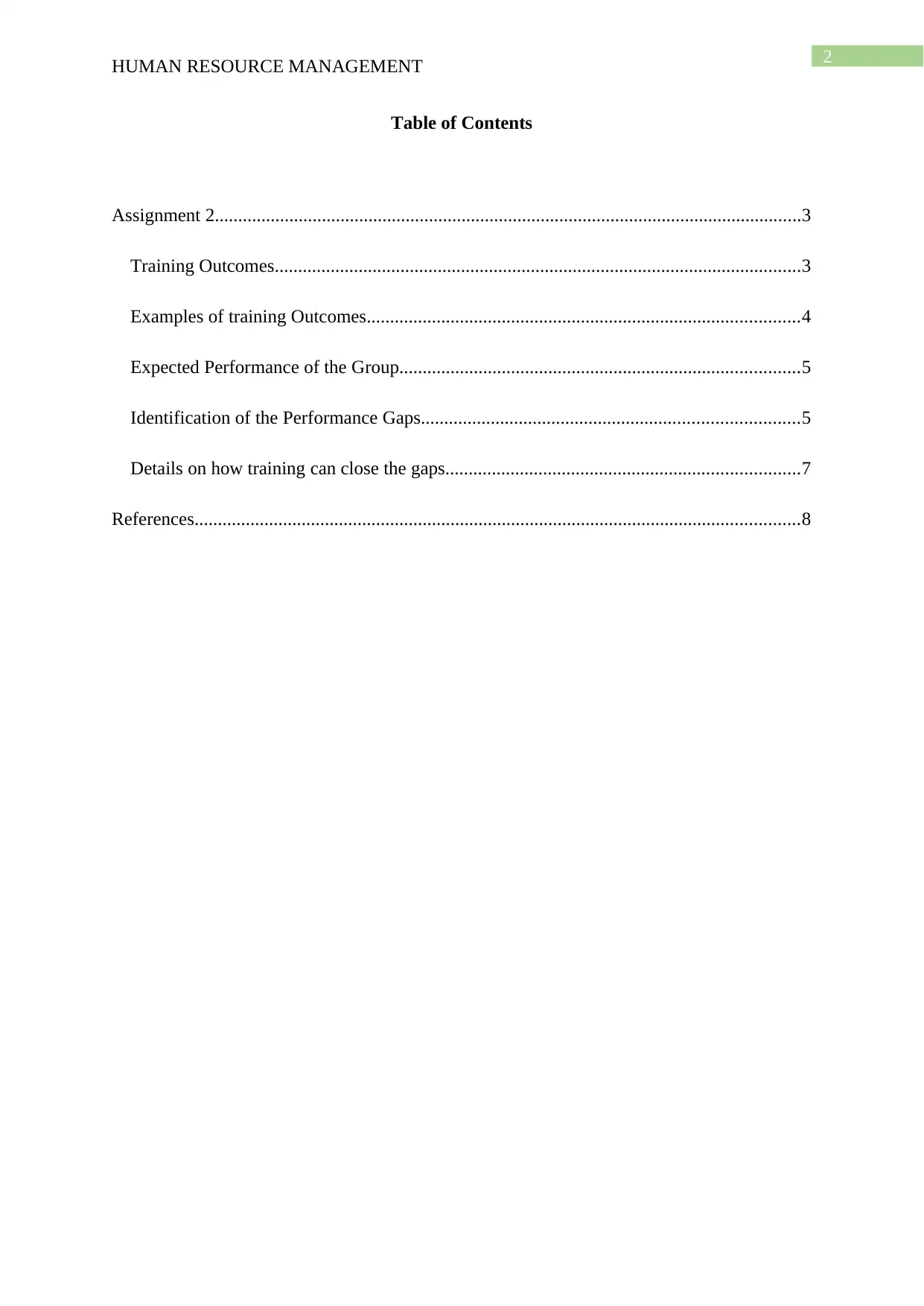
2
HUMAN RESOURCE MANAGEMENT
Table of Contents
Assignment 2..............................................................................................................................3
Training Outcomes.................................................................................................................3
Examples of training Outcomes.............................................................................................4
Expected Performance of the Group......................................................................................5
Identification of the Performance Gaps.................................................................................5
Details on how training can close the gaps............................................................................7
References..................................................................................................................................8
HUMAN RESOURCE MANAGEMENT
Table of Contents
Assignment 2..............................................................................................................................3
Training Outcomes.................................................................................................................3
Examples of training Outcomes.............................................................................................4
Expected Performance of the Group......................................................................................5
Identification of the Performance Gaps.................................................................................5
Details on how training can close the gaps............................................................................7
References..................................................................................................................................8
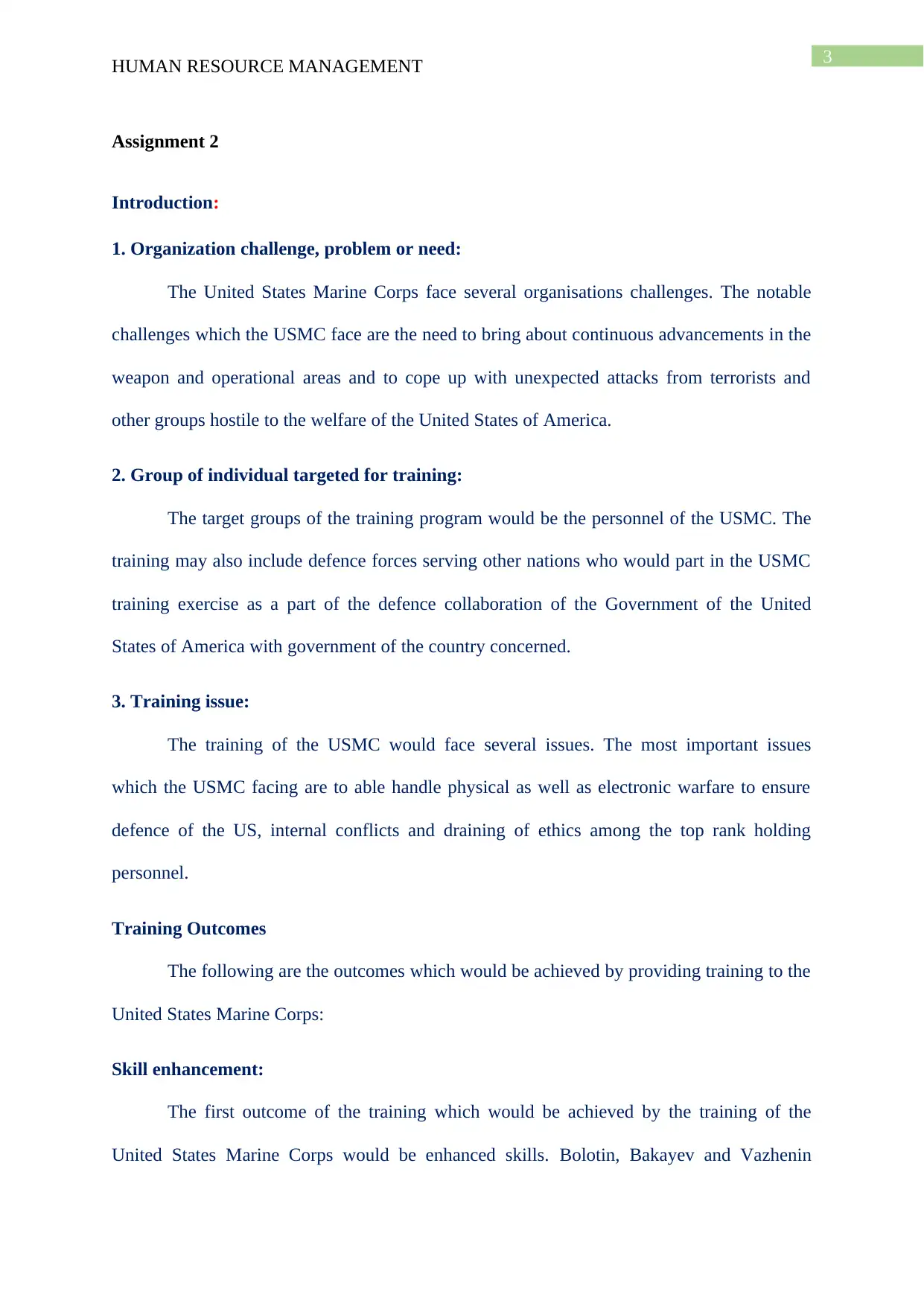
3
HUMAN RESOURCE MANAGEMENT
Assignment 2
Introduction:
1. Organization challenge, problem or need:
The United States Marine Corps face several organisations challenges. The notable
challenges which the USMC face are the need to bring about continuous advancements in the
weapon and operational areas and to cope up with unexpected attacks from terrorists and
other groups hostile to the welfare of the United States of America.
2. Group of individual targeted for training:
The target groups of the training program would be the personnel of the USMC. The
training may also include defence forces serving other nations who would part in the USMC
training exercise as a part of the defence collaboration of the Government of the United
States of America with government of the country concerned.
3. Training issue:
The training of the USMC would face several issues. The most important issues
which the USMC facing are to able handle physical as well as electronic warfare to ensure
defence of the US, internal conflicts and draining of ethics among the top rank holding
personnel.
Training Outcomes
The following are the outcomes which would be achieved by providing training to the
United States Marine Corps:
Skill enhancement:
The first outcome of the training which would be achieved by the training of the
United States Marine Corps would be enhanced skills. Bolotin, Bakayev and Vazhenin
HUMAN RESOURCE MANAGEMENT
Assignment 2
Introduction:
1. Organization challenge, problem or need:
The United States Marine Corps face several organisations challenges. The notable
challenges which the USMC face are the need to bring about continuous advancements in the
weapon and operational areas and to cope up with unexpected attacks from terrorists and
other groups hostile to the welfare of the United States of America.
2. Group of individual targeted for training:
The target groups of the training program would be the personnel of the USMC. The
training may also include defence forces serving other nations who would part in the USMC
training exercise as a part of the defence collaboration of the Government of the United
States of America with government of the country concerned.
3. Training issue:
The training of the USMC would face several issues. The most important issues
which the USMC facing are to able handle physical as well as electronic warfare to ensure
defence of the US, internal conflicts and draining of ethics among the top rank holding
personnel.
Training Outcomes
The following are the outcomes which would be achieved by providing training to the
United States Marine Corps:
Skill enhancement:
The first outcome of the training which would be achieved by the training of the
United States Marine Corps would be enhanced skills. Bolotin, Bakayev and Vazhenin
⊘ This is a preview!⊘
Do you want full access?
Subscribe today to unlock all pages.

Trusted by 1+ million students worldwide
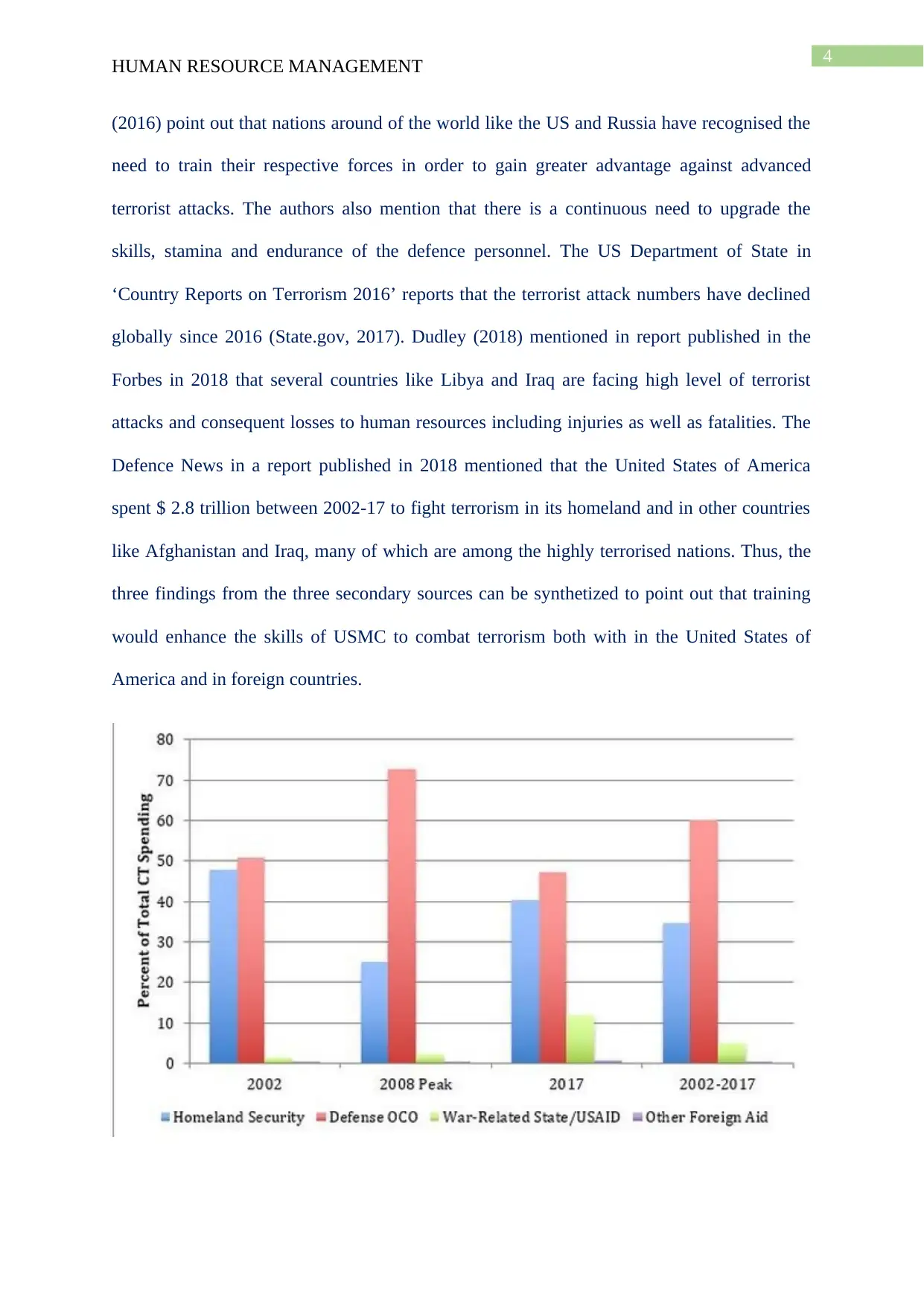
4
HUMAN RESOURCE MANAGEMENT
(2016) point out that nations around of the world like the US and Russia have recognised the
need to train their respective forces in order to gain greater advantage against advanced
terrorist attacks. The authors also mention that there is a continuous need to upgrade the
skills, stamina and endurance of the defence personnel. The US Department of State in
‘Country Reports on Terrorism 2016’ reports that the terrorist attack numbers have declined
globally since 2016 (State.gov, 2017). Dudley (2018) mentioned in report published in the
Forbes in 2018 that several countries like Libya and Iraq are facing high level of terrorist
attacks and consequent losses to human resources including injuries as well as fatalities. The
Defence News in a report published in 2018 mentioned that the United States of America
spent $ 2.8 trillion between 2002-17 to fight terrorism in its homeland and in other countries
like Afghanistan and Iraq, many of which are among the highly terrorised nations. Thus, the
three findings from the three secondary sources can be synthetized to point out that training
would enhance the skills of USMC to combat terrorism both with in the United States of
America and in foreign countries.
HUMAN RESOURCE MANAGEMENT
(2016) point out that nations around of the world like the US and Russia have recognised the
need to train their respective forces in order to gain greater advantage against advanced
terrorist attacks. The authors also mention that there is a continuous need to upgrade the
skills, stamina and endurance of the defence personnel. The US Department of State in
‘Country Reports on Terrorism 2016’ reports that the terrorist attack numbers have declined
globally since 2016 (State.gov, 2017). Dudley (2018) mentioned in report published in the
Forbes in 2018 that several countries like Libya and Iraq are facing high level of terrorist
attacks and consequent losses to human resources including injuries as well as fatalities. The
Defence News in a report published in 2018 mentioned that the United States of America
spent $ 2.8 trillion between 2002-17 to fight terrorism in its homeland and in other countries
like Afghanistan and Iraq, many of which are among the highly terrorised nations. Thus, the
three findings from the three secondary sources can be synthetized to point out that training
would enhance the skills of USMC to combat terrorism both with in the United States of
America and in foreign countries.
Paraphrase This Document
Need a fresh take? Get an instant paraphrase of this document with our AI Paraphraser
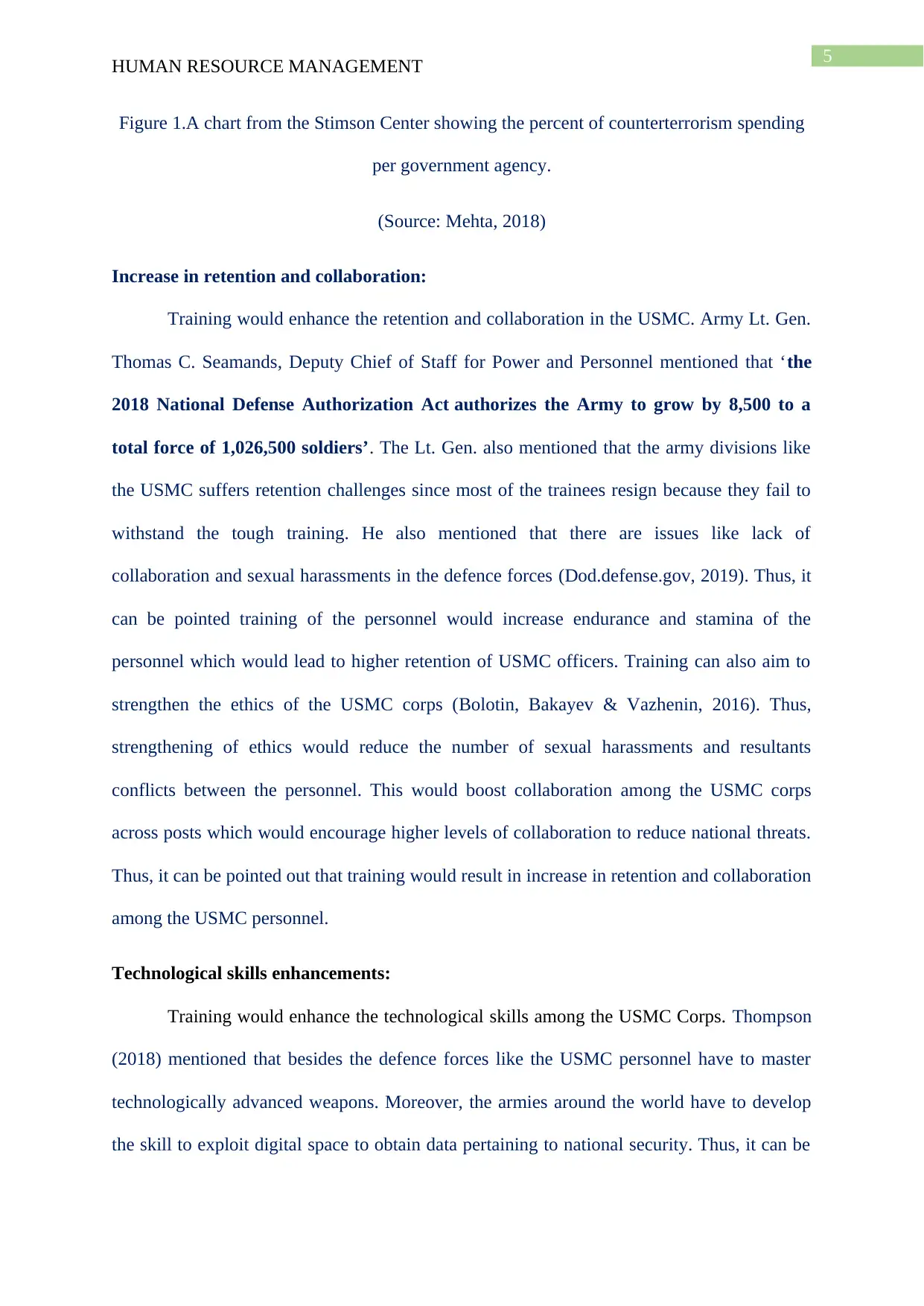
5
HUMAN RESOURCE MANAGEMENT
Figure 1.A chart from the Stimson Center showing the percent of counterterrorism spending
per government agency.
(Source: Mehta, 2018)
Increase in retention and collaboration:
Training would enhance the retention and collaboration in the USMC. Army Lt. Gen.
Thomas C. Seamands, Deputy Chief of Staff for Power and Personnel mentioned that ‘the
2018 National Defense Authorization Act authorizes the Army to grow by 8,500 to a
total force of 1,026,500 soldiers’. The Lt. Gen. also mentioned that the army divisions like
the USMC suffers retention challenges since most of the trainees resign because they fail to
withstand the tough training. He also mentioned that there are issues like lack of
collaboration and sexual harassments in the defence forces (Dod.defense.gov, 2019). Thus, it
can be pointed training of the personnel would increase endurance and stamina of the
personnel which would lead to higher retention of USMC officers. Training can also aim to
strengthen the ethics of the USMC corps (Bolotin, Bakayev & Vazhenin, 2016). Thus,
strengthening of ethics would reduce the number of sexual harassments and resultants
conflicts between the personnel. This would boost collaboration among the USMC corps
across posts which would encourage higher levels of collaboration to reduce national threats.
Thus, it can be pointed out that training would result in increase in retention and collaboration
among the USMC personnel.
Technological skills enhancements:
Training would enhance the technological skills among the USMC Corps. Thompson
(2018) mentioned that besides the defence forces like the USMC personnel have to master
technologically advanced weapons. Moreover, the armies around the world have to develop
the skill to exploit digital space to obtain data pertaining to national security. Thus, it can be
HUMAN RESOURCE MANAGEMENT
Figure 1.A chart from the Stimson Center showing the percent of counterterrorism spending
per government agency.
(Source: Mehta, 2018)
Increase in retention and collaboration:
Training would enhance the retention and collaboration in the USMC. Army Lt. Gen.
Thomas C. Seamands, Deputy Chief of Staff for Power and Personnel mentioned that ‘the
2018 National Defense Authorization Act authorizes the Army to grow by 8,500 to a
total force of 1,026,500 soldiers’. The Lt. Gen. also mentioned that the army divisions like
the USMC suffers retention challenges since most of the trainees resign because they fail to
withstand the tough training. He also mentioned that there are issues like lack of
collaboration and sexual harassments in the defence forces (Dod.defense.gov, 2019). Thus, it
can be pointed training of the personnel would increase endurance and stamina of the
personnel which would lead to higher retention of USMC officers. Training can also aim to
strengthen the ethics of the USMC corps (Bolotin, Bakayev & Vazhenin, 2016). Thus,
strengthening of ethics would reduce the number of sexual harassments and resultants
conflicts between the personnel. This would boost collaboration among the USMC corps
across posts which would encourage higher levels of collaboration to reduce national threats.
Thus, it can be pointed out that training would result in increase in retention and collaboration
among the USMC personnel.
Technological skills enhancements:
Training would enhance the technological skills among the USMC Corps. Thompson
(2018) mentioned that besides the defence forces like the USMC personnel have to master
technologically advanced weapons. Moreover, the armies around the world have to develop
the skill to exploit digital space to obtain data pertaining to national security. Thus, it can be
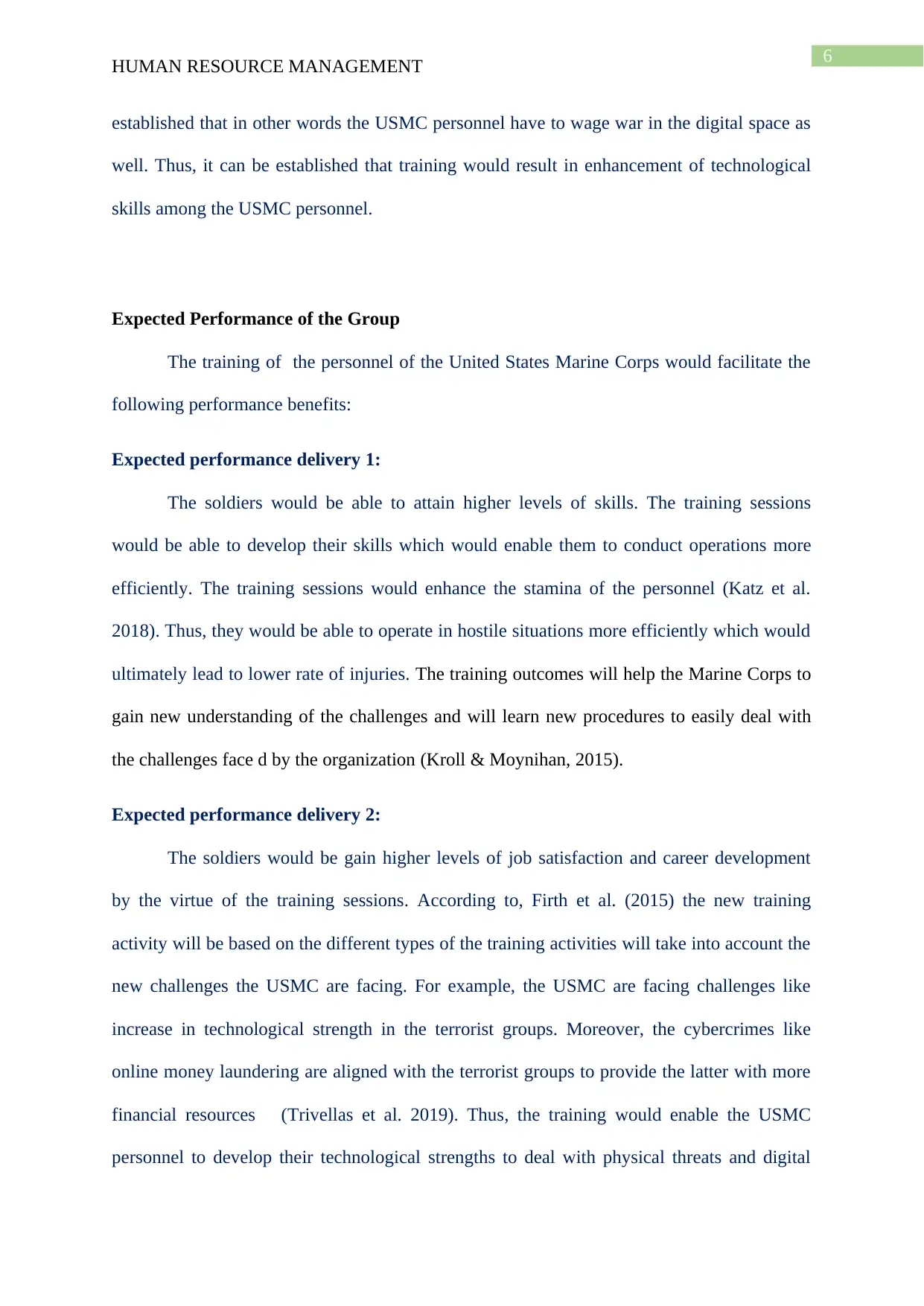
6
HUMAN RESOURCE MANAGEMENT
established that in other words the USMC personnel have to wage war in the digital space as
well. Thus, it can be established that training would result in enhancement of technological
skills among the USMC personnel.
Expected Performance of the Group
The training of the personnel of the United States Marine Corps would facilitate the
following performance benefits:
Expected performance delivery 1:
The soldiers would be able to attain higher levels of skills. The training sessions
would be able to develop their skills which would enable them to conduct operations more
efficiently. The training sessions would enhance the stamina of the personnel (Katz et al.
2018). Thus, they would be able to operate in hostile situations more efficiently which would
ultimately lead to lower rate of injuries. The training outcomes will help the Marine Corps to
gain new understanding of the challenges and will learn new procedures to easily deal with
the challenges face d by the organization (Kroll & Moynihan, 2015).
Expected performance delivery 2:
The soldiers would be gain higher levels of job satisfaction and career development
by the virtue of the training sessions. According to, Firth et al. (2015) the new training
activity will be based on the different types of the training activities will take into account the
new challenges the USMC are facing. For example, the USMC are facing challenges like
increase in technological strength in the terrorist groups. Moreover, the cybercrimes like
online money laundering are aligned with the terrorist groups to provide the latter with more
financial resources (Trivellas et al. 2019). Thus, the training would enable the USMC
personnel to develop their technological strengths to deal with physical threats and digital
HUMAN RESOURCE MANAGEMENT
established that in other words the USMC personnel have to wage war in the digital space as
well. Thus, it can be established that training would result in enhancement of technological
skills among the USMC personnel.
Expected Performance of the Group
The training of the personnel of the United States Marine Corps would facilitate the
following performance benefits:
Expected performance delivery 1:
The soldiers would be able to attain higher levels of skills. The training sessions
would be able to develop their skills which would enable them to conduct operations more
efficiently. The training sessions would enhance the stamina of the personnel (Katz et al.
2018). Thus, they would be able to operate in hostile situations more efficiently which would
ultimately lead to lower rate of injuries. The training outcomes will help the Marine Corps to
gain new understanding of the challenges and will learn new procedures to easily deal with
the challenges face d by the organization (Kroll & Moynihan, 2015).
Expected performance delivery 2:
The soldiers would be gain higher levels of job satisfaction and career development
by the virtue of the training sessions. According to, Firth et al. (2015) the new training
activity will be based on the different types of the training activities will take into account the
new challenges the USMC are facing. For example, the USMC are facing challenges like
increase in technological strength in the terrorist groups. Moreover, the cybercrimes like
online money laundering are aligned with the terrorist groups to provide the latter with more
financial resources (Trivellas et al. 2019). Thus, the training would enable the USMC
personnel to develop their technological strengths to deal with physical threats and digital
⊘ This is a preview!⊘
Do you want full access?
Subscribe today to unlock all pages.

Trusted by 1+ million students worldwide
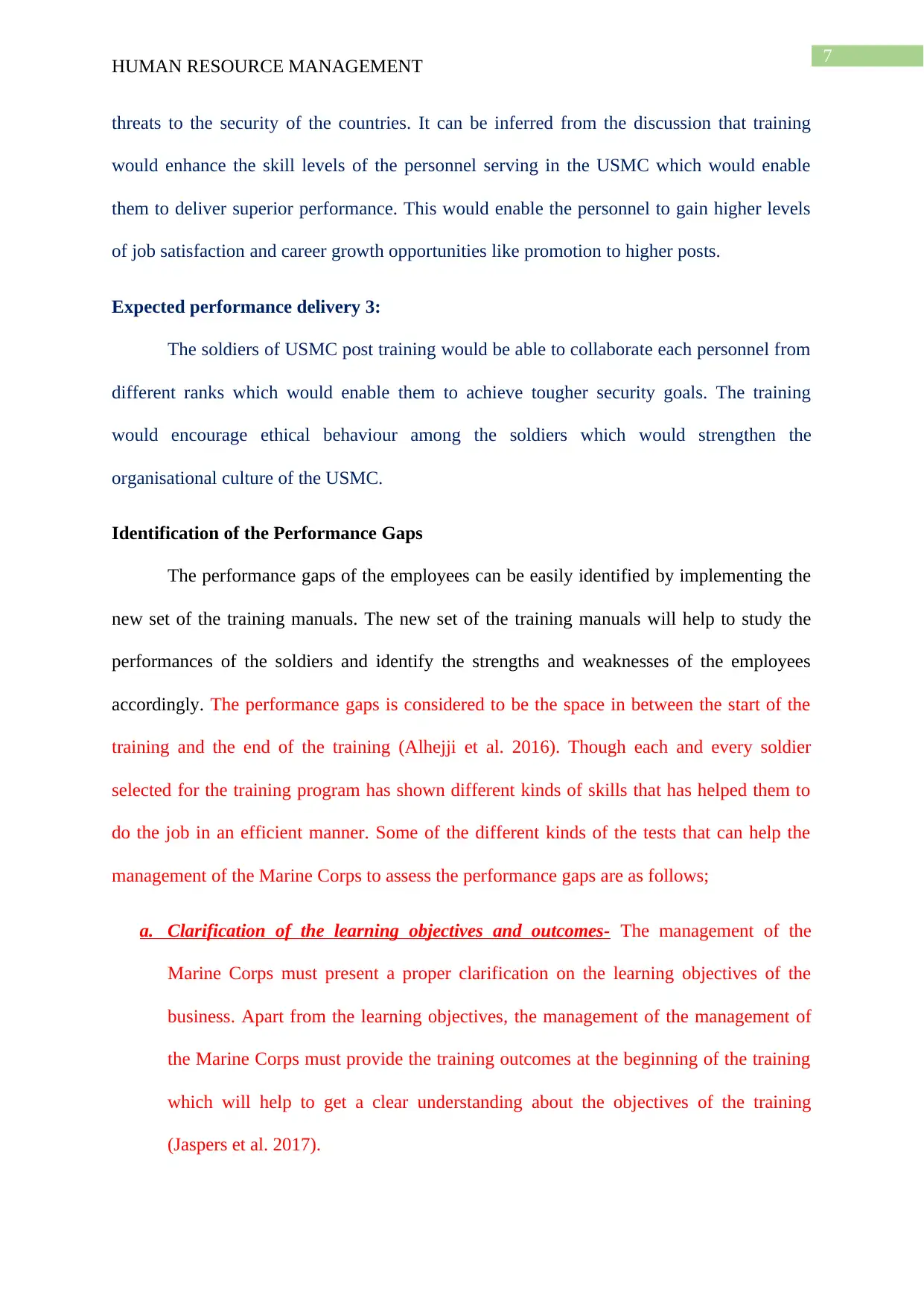
7
HUMAN RESOURCE MANAGEMENT
threats to the security of the countries. It can be inferred from the discussion that training
would enhance the skill levels of the personnel serving in the USMC which would enable
them to deliver superior performance. This would enable the personnel to gain higher levels
of job satisfaction and career growth opportunities like promotion to higher posts.
Expected performance delivery 3:
The soldiers of USMC post training would be able to collaborate each personnel from
different ranks which would enable them to achieve tougher security goals. The training
would encourage ethical behaviour among the soldiers which would strengthen the
organisational culture of the USMC.
Identification of the Performance Gaps
The performance gaps of the employees can be easily identified by implementing the
new set of the training manuals. The new set of the training manuals will help to study the
performances of the soldiers and identify the strengths and weaknesses of the employees
accordingly. The performance gaps is considered to be the space in between the start of the
training and the end of the training (Alhejji et al. 2016). Though each and every soldier
selected for the training program has shown different kinds of skills that has helped them to
do the job in an efficient manner. Some of the different kinds of the tests that can help the
management of the Marine Corps to assess the performance gaps are as follows;
a. Clarification of the learning objectives and outcomes- The management of the
Marine Corps must present a proper clarification on the learning objectives of the
business. Apart from the learning objectives, the management of the management of
the Marine Corps must provide the training outcomes at the beginning of the training
which will help to get a clear understanding about the objectives of the training
(Jaspers et al. 2017).
HUMAN RESOURCE MANAGEMENT
threats to the security of the countries. It can be inferred from the discussion that training
would enhance the skill levels of the personnel serving in the USMC which would enable
them to deliver superior performance. This would enable the personnel to gain higher levels
of job satisfaction and career growth opportunities like promotion to higher posts.
Expected performance delivery 3:
The soldiers of USMC post training would be able to collaborate each personnel from
different ranks which would enable them to achieve tougher security goals. The training
would encourage ethical behaviour among the soldiers which would strengthen the
organisational culture of the USMC.
Identification of the Performance Gaps
The performance gaps of the employees can be easily identified by implementing the
new set of the training manuals. The new set of the training manuals will help to study the
performances of the soldiers and identify the strengths and weaknesses of the employees
accordingly. The performance gaps is considered to be the space in between the start of the
training and the end of the training (Alhejji et al. 2016). Though each and every soldier
selected for the training program has shown different kinds of skills that has helped them to
do the job in an efficient manner. Some of the different kinds of the tests that can help the
management of the Marine Corps to assess the performance gaps are as follows;
a. Clarification of the learning objectives and outcomes- The management of the
Marine Corps must present a proper clarification on the learning objectives of the
business. Apart from the learning objectives, the management of the management of
the Marine Corps must provide the training outcomes at the beginning of the training
which will help to get a clear understanding about the objectives of the training
(Jaspers et al. 2017).
Paraphrase This Document
Need a fresh take? Get an instant paraphrase of this document with our AI Paraphraser
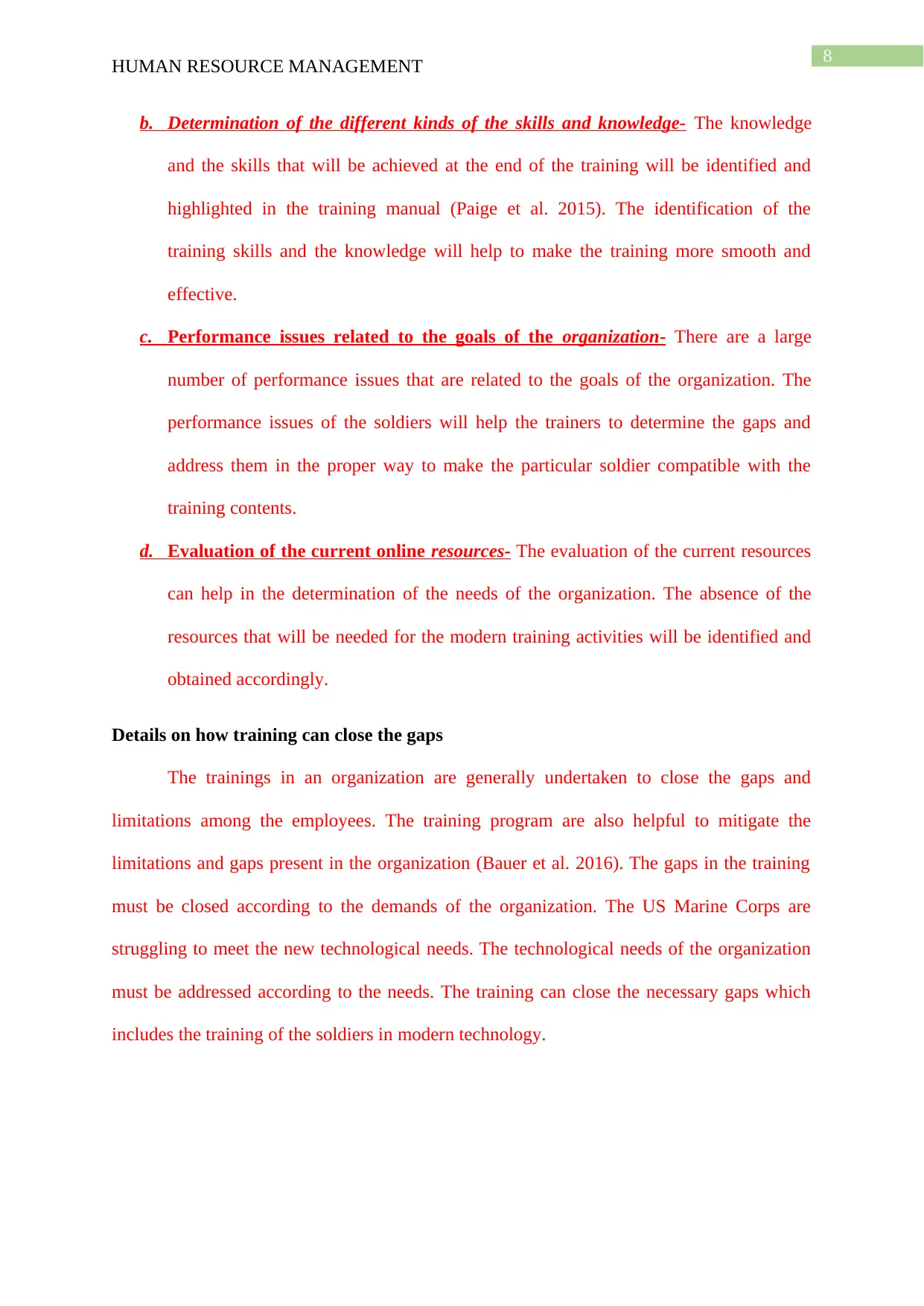
8
HUMAN RESOURCE MANAGEMENT
b. Determination of the different kinds of the skills and knowledge- The knowledge
and the skills that will be achieved at the end of the training will be identified and
highlighted in the training manual (Paige et al. 2015). The identification of the
training skills and the knowledge will help to make the training more smooth and
effective.
c. Performance issues related to the goals of the organization- There are a large
number of performance issues that are related to the goals of the organization. The
performance issues of the soldiers will help the trainers to determine the gaps and
address them in the proper way to make the particular soldier compatible with the
training contents.
d. Evaluation of the current online resources- The evaluation of the current resources
can help in the determination of the needs of the organization. The absence of the
resources that will be needed for the modern training activities will be identified and
obtained accordingly.
Details on how training can close the gaps
The trainings in an organization are generally undertaken to close the gaps and
limitations among the employees. The training program are also helpful to mitigate the
limitations and gaps present in the organization (Bauer et al. 2016). The gaps in the training
must be closed according to the demands of the organization. The US Marine Corps are
struggling to meet the new technological needs. The technological needs of the organization
must be addressed according to the needs. The training can close the necessary gaps which
includes the training of the soldiers in modern technology.
HUMAN RESOURCE MANAGEMENT
b. Determination of the different kinds of the skills and knowledge- The knowledge
and the skills that will be achieved at the end of the training will be identified and
highlighted in the training manual (Paige et al. 2015). The identification of the
training skills and the knowledge will help to make the training more smooth and
effective.
c. Performance issues related to the goals of the organization- There are a large
number of performance issues that are related to the goals of the organization. The
performance issues of the soldiers will help the trainers to determine the gaps and
address them in the proper way to make the particular soldier compatible with the
training contents.
d. Evaluation of the current online resources- The evaluation of the current resources
can help in the determination of the needs of the organization. The absence of the
resources that will be needed for the modern training activities will be identified and
obtained accordingly.
Details on how training can close the gaps
The trainings in an organization are generally undertaken to close the gaps and
limitations among the employees. The training program are also helpful to mitigate the
limitations and gaps present in the organization (Bauer et al. 2016). The gaps in the training
must be closed according to the demands of the organization. The US Marine Corps are
struggling to meet the new technological needs. The technological needs of the organization
must be addressed according to the needs. The training can close the necessary gaps which
includes the training of the soldiers in modern technology.
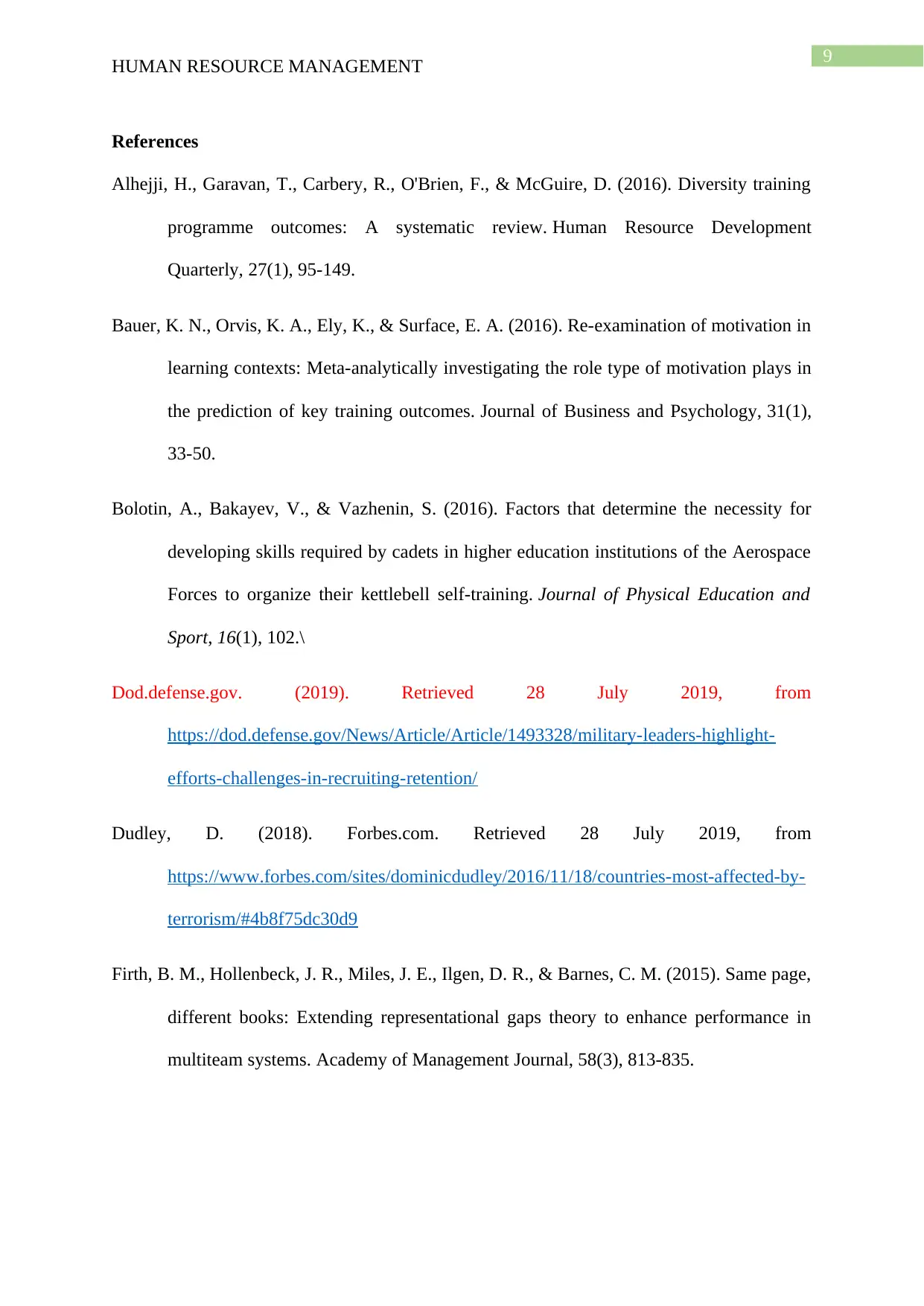
9
HUMAN RESOURCE MANAGEMENT
References
Alhejji, H., Garavan, T., Carbery, R., O'Brien, F., & McGuire, D. (2016). Diversity training
programme outcomes: A systematic review. Human Resource Development
Quarterly, 27(1), 95-149.
Bauer, K. N., Orvis, K. A., Ely, K., & Surface, E. A. (2016). Re-examination of motivation in
learning contexts: Meta-analytically investigating the role type of motivation plays in
the prediction of key training outcomes. Journal of Business and Psychology, 31(1),
33-50.
Bolotin, A., Bakayev, V., & Vazhenin, S. (2016). Factors that determine the necessity for
developing skills required by cadets in higher education institutions of the Aerospace
Forces to organize their kettlebell self-training. Journal of Physical Education and
Sport, 16(1), 102.\
Dod.defense.gov. (2019). Retrieved 28 July 2019, from
https://dod.defense.gov/News/Article/Article/1493328/military-leaders-highlight-
efforts-challenges-in-recruiting-retention/
Dudley, D. (2018). Forbes.com. Retrieved 28 July 2019, from
https://www.forbes.com/sites/dominicdudley/2016/11/18/countries-most-affected-by-
terrorism/#4b8f75dc30d9
Firth, B. M., Hollenbeck, J. R., Miles, J. E., Ilgen, D. R., & Barnes, C. M. (2015). Same page,
different books: Extending representational gaps theory to enhance performance in
multiteam systems. Academy of Management Journal, 58(3), 813-835.
HUMAN RESOURCE MANAGEMENT
References
Alhejji, H., Garavan, T., Carbery, R., O'Brien, F., & McGuire, D. (2016). Diversity training
programme outcomes: A systematic review. Human Resource Development
Quarterly, 27(1), 95-149.
Bauer, K. N., Orvis, K. A., Ely, K., & Surface, E. A. (2016). Re-examination of motivation in
learning contexts: Meta-analytically investigating the role type of motivation plays in
the prediction of key training outcomes. Journal of Business and Psychology, 31(1),
33-50.
Bolotin, A., Bakayev, V., & Vazhenin, S. (2016). Factors that determine the necessity for
developing skills required by cadets in higher education institutions of the Aerospace
Forces to organize their kettlebell self-training. Journal of Physical Education and
Sport, 16(1), 102.\
Dod.defense.gov. (2019). Retrieved 28 July 2019, from
https://dod.defense.gov/News/Article/Article/1493328/military-leaders-highlight-
efforts-challenges-in-recruiting-retention/
Dudley, D. (2018). Forbes.com. Retrieved 28 July 2019, from
https://www.forbes.com/sites/dominicdudley/2016/11/18/countries-most-affected-by-
terrorism/#4b8f75dc30d9
Firth, B. M., Hollenbeck, J. R., Miles, J. E., Ilgen, D. R., & Barnes, C. M. (2015). Same page,
different books: Extending representational gaps theory to enhance performance in
multiteam systems. Academy of Management Journal, 58(3), 813-835.
⊘ This is a preview!⊘
Do you want full access?
Subscribe today to unlock all pages.

Trusted by 1+ million students worldwide
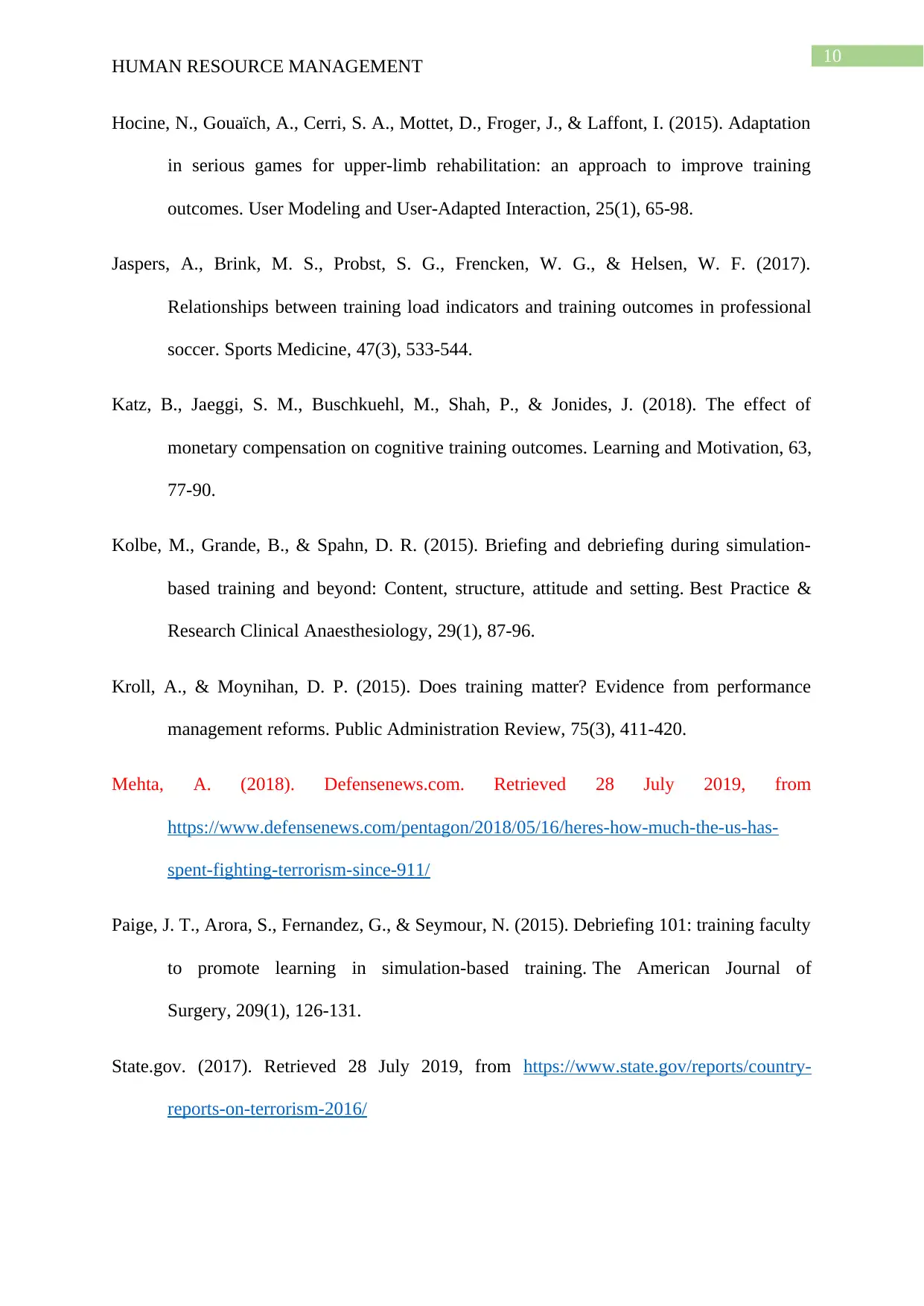
10
HUMAN RESOURCE MANAGEMENT
Hocine, N., Gouaïch, A., Cerri, S. A., Mottet, D., Froger, J., & Laffont, I. (2015). Adaptation
in serious games for upper-limb rehabilitation: an approach to improve training
outcomes. User Modeling and User-Adapted Interaction, 25(1), 65-98.
Jaspers, A., Brink, M. S., Probst, S. G., Frencken, W. G., & Helsen, W. F. (2017).
Relationships between training load indicators and training outcomes in professional
soccer. Sports Medicine, 47(3), 533-544.
Katz, B., Jaeggi, S. M., Buschkuehl, M., Shah, P., & Jonides, J. (2018). The effect of
monetary compensation on cognitive training outcomes. Learning and Motivation, 63,
77-90.
Kolbe, M., Grande, B., & Spahn, D. R. (2015). Briefing and debriefing during simulation-
based training and beyond: Content, structure, attitude and setting. Best Practice &
Research Clinical Anaesthesiology, 29(1), 87-96.
Kroll, A., & Moynihan, D. P. (2015). Does training matter? Evidence from performance
management reforms. Public Administration Review, 75(3), 411-420.
Mehta, A. (2018). Defensenews.com. Retrieved 28 July 2019, from
https://www.defensenews.com/pentagon/2018/05/16/heres-how-much-the-us-has-
spent-fighting-terrorism-since-911/
Paige, J. T., Arora, S., Fernandez, G., & Seymour, N. (2015). Debriefing 101: training faculty
to promote learning in simulation-based training. The American Journal of
Surgery, 209(1), 126-131.
State.gov. (2017). Retrieved 28 July 2019, from https://www.state.gov/reports/country-
reports-on-terrorism-2016/
HUMAN RESOURCE MANAGEMENT
Hocine, N., Gouaïch, A., Cerri, S. A., Mottet, D., Froger, J., & Laffont, I. (2015). Adaptation
in serious games for upper-limb rehabilitation: an approach to improve training
outcomes. User Modeling and User-Adapted Interaction, 25(1), 65-98.
Jaspers, A., Brink, M. S., Probst, S. G., Frencken, W. G., & Helsen, W. F. (2017).
Relationships between training load indicators and training outcomes in professional
soccer. Sports Medicine, 47(3), 533-544.
Katz, B., Jaeggi, S. M., Buschkuehl, M., Shah, P., & Jonides, J. (2018). The effect of
monetary compensation on cognitive training outcomes. Learning and Motivation, 63,
77-90.
Kolbe, M., Grande, B., & Spahn, D. R. (2015). Briefing and debriefing during simulation-
based training and beyond: Content, structure, attitude and setting. Best Practice &
Research Clinical Anaesthesiology, 29(1), 87-96.
Kroll, A., & Moynihan, D. P. (2015). Does training matter? Evidence from performance
management reforms. Public Administration Review, 75(3), 411-420.
Mehta, A. (2018). Defensenews.com. Retrieved 28 July 2019, from
https://www.defensenews.com/pentagon/2018/05/16/heres-how-much-the-us-has-
spent-fighting-terrorism-since-911/
Paige, J. T., Arora, S., Fernandez, G., & Seymour, N. (2015). Debriefing 101: training faculty
to promote learning in simulation-based training. The American Journal of
Surgery, 209(1), 126-131.
State.gov. (2017). Retrieved 28 July 2019, from https://www.state.gov/reports/country-
reports-on-terrorism-2016/
Paraphrase This Document
Need a fresh take? Get an instant paraphrase of this document with our AI Paraphraser
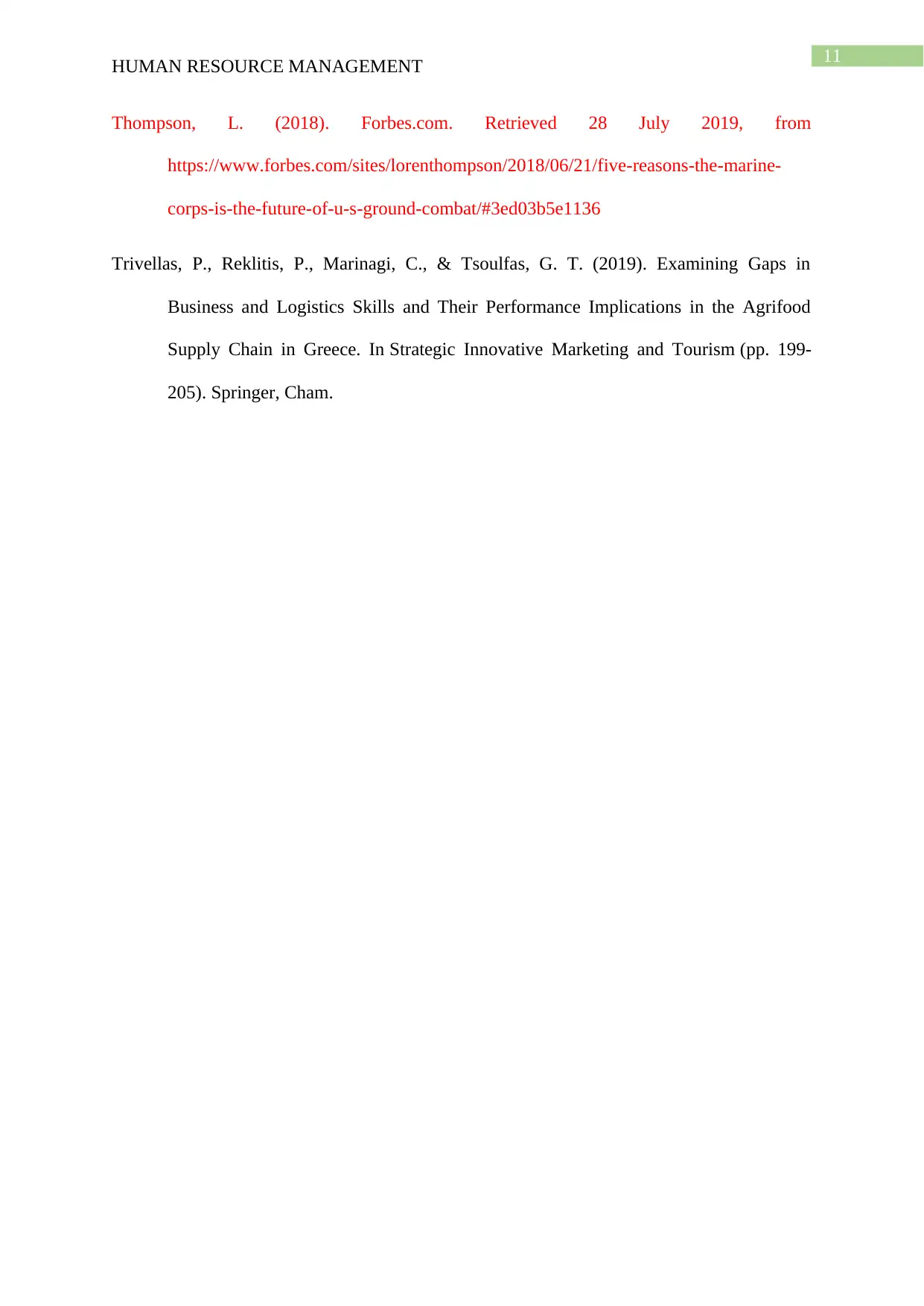
11
HUMAN RESOURCE MANAGEMENT
Thompson, L. (2018). Forbes.com. Retrieved 28 July 2019, from
https://www.forbes.com/sites/lorenthompson/2018/06/21/five-reasons-the-marine-
corps-is-the-future-of-u-s-ground-combat/#3ed03b5e1136
Trivellas, P., Reklitis, P., Marinagi, C., & Tsoulfas, G. T. (2019). Examining Gaps in
Business and Logistics Skills and Their Performance Implications in the Agrifood
Supply Chain in Greece. In Strategic Innovative Marketing and Tourism (pp. 199-
205). Springer, Cham.
HUMAN RESOURCE MANAGEMENT
Thompson, L. (2018). Forbes.com. Retrieved 28 July 2019, from
https://www.forbes.com/sites/lorenthompson/2018/06/21/five-reasons-the-marine-
corps-is-the-future-of-u-s-ground-combat/#3ed03b5e1136
Trivellas, P., Reklitis, P., Marinagi, C., & Tsoulfas, G. T. (2019). Examining Gaps in
Business and Logistics Skills and Their Performance Implications in the Agrifood
Supply Chain in Greece. In Strategic Innovative Marketing and Tourism (pp. 199-
205). Springer, Cham.
1 out of 11
Related Documents
Your All-in-One AI-Powered Toolkit for Academic Success.
+13062052269
info@desklib.com
Available 24*7 on WhatsApp / Email
![[object Object]](/_next/static/media/star-bottom.7253800d.svg)
Unlock your academic potential
Copyright © 2020–2025 A2Z Services. All Rights Reserved. Developed and managed by ZUCOL.




